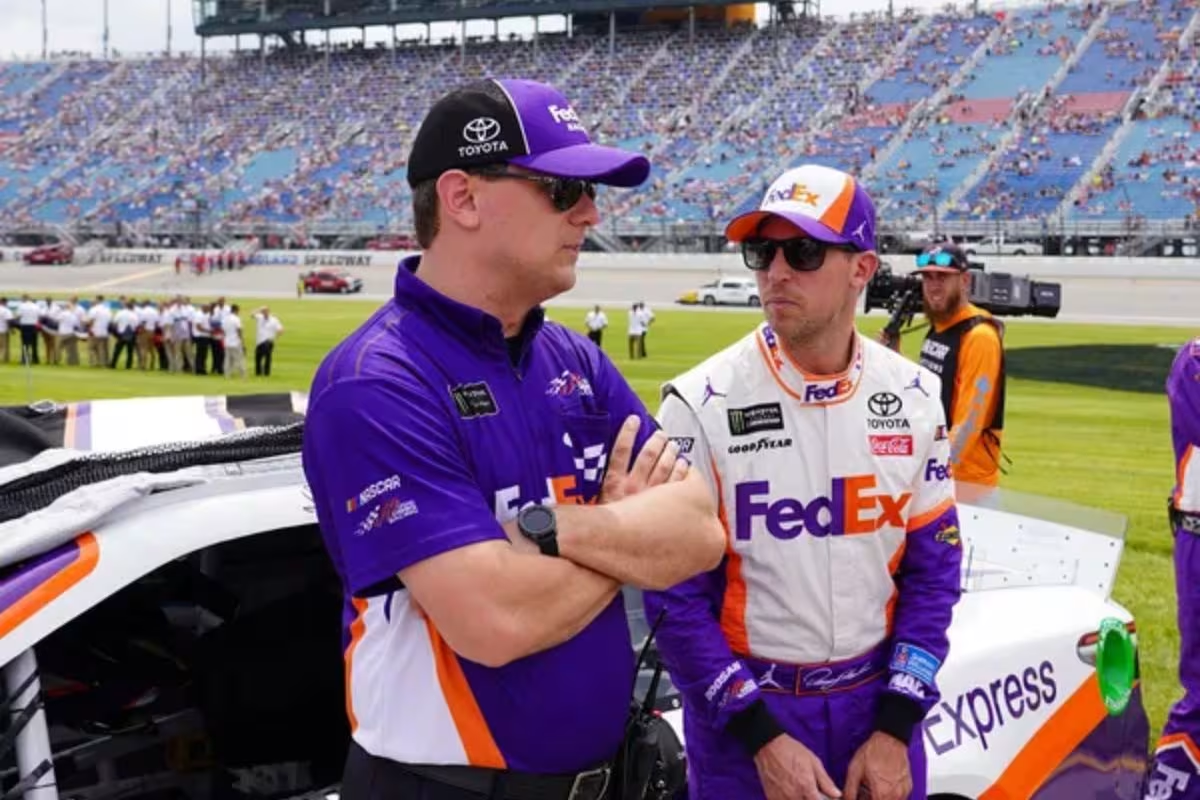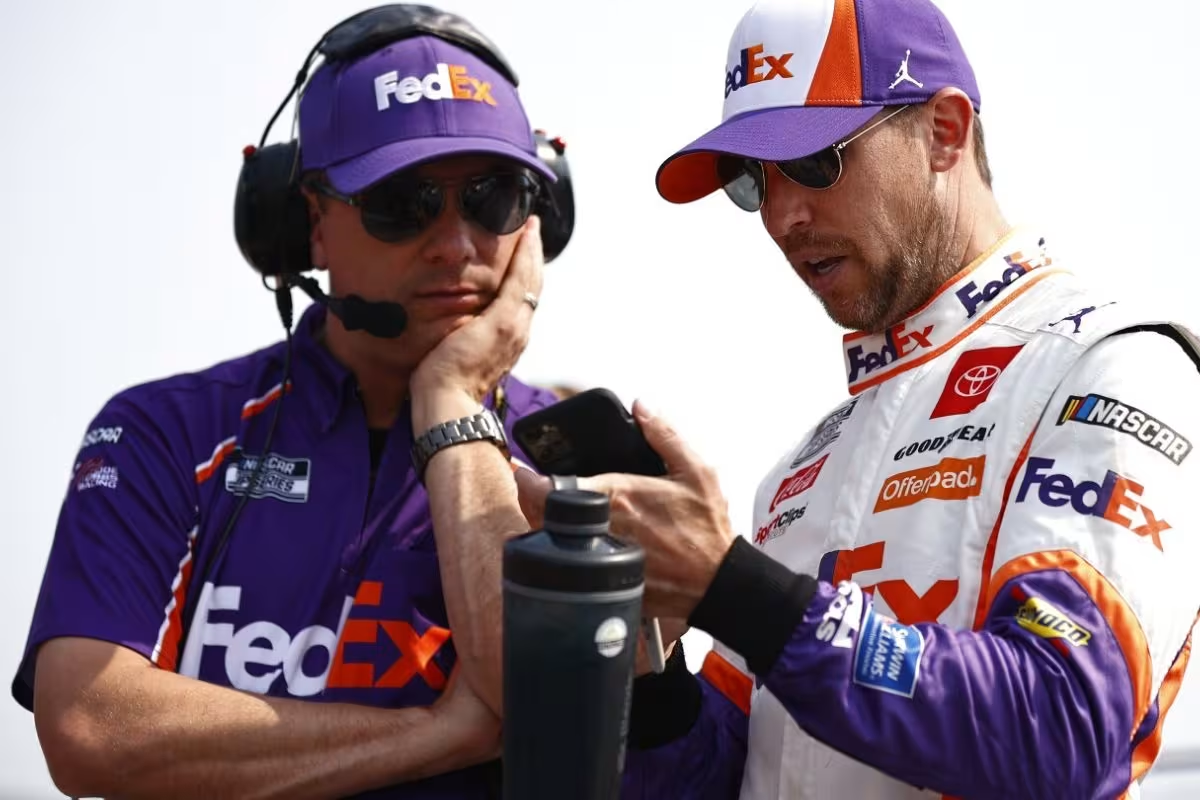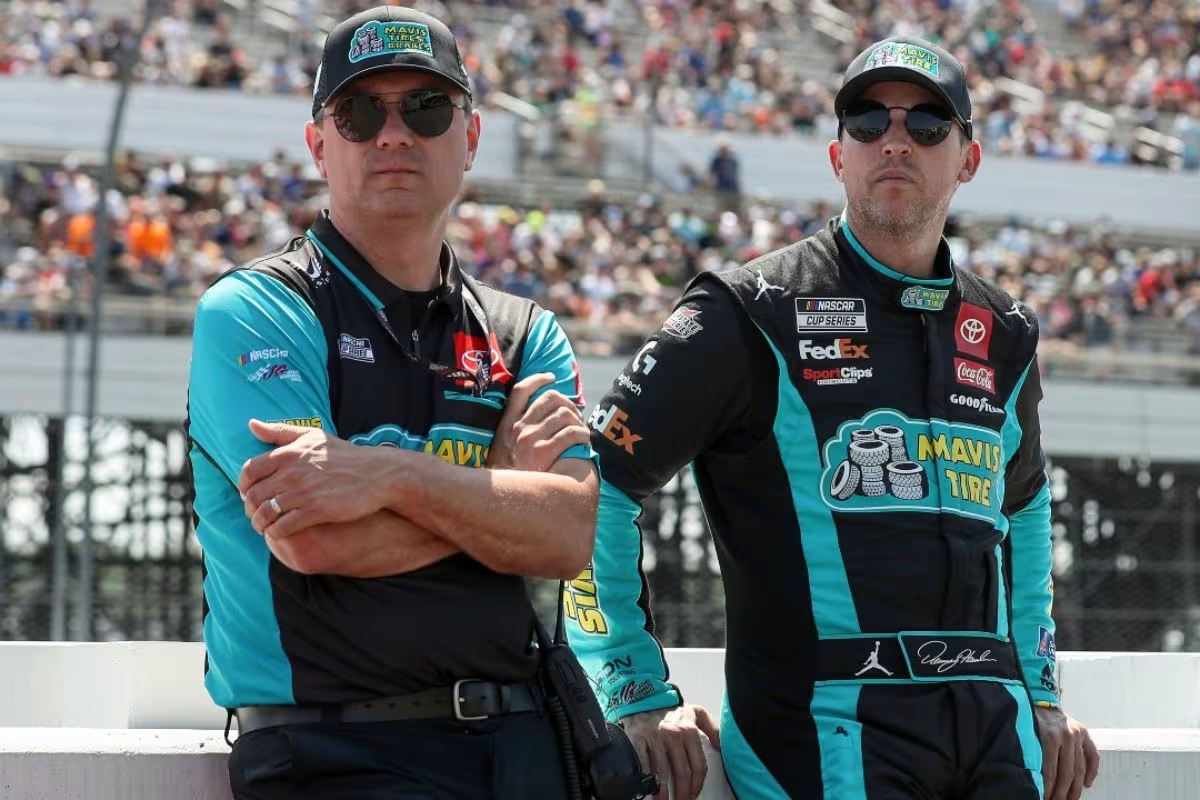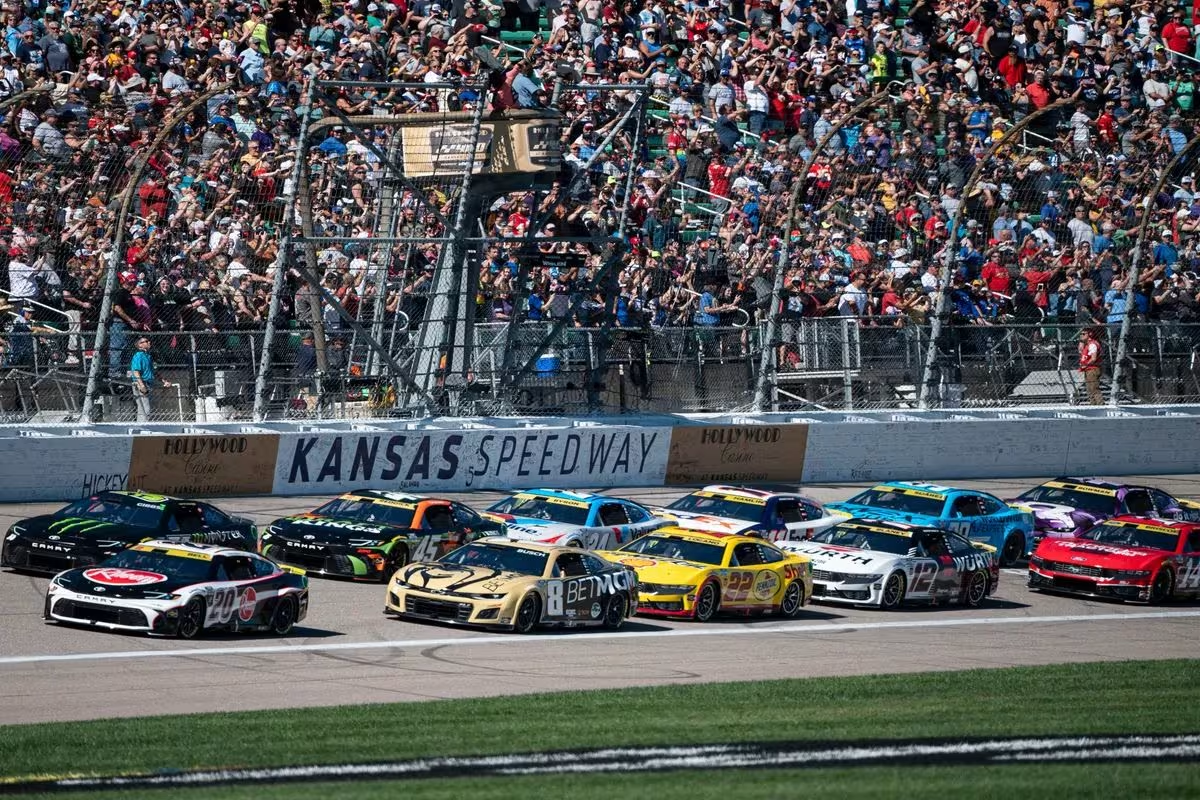Denny Hamlin’s Crew Chief on NASCAR: Chris Gabehart, a well-known crew chief in the NASCAR Cup Series, has shared his thoughts on the Next Gen car, and his views raise some important questions. He believes the Gen 7 car has not met expectations, especially after wild races like Talladega. With drivers struggling to pass and relying more on luck, Gabehart’s insights reveal deeper issues in NASCAR’s design. What does this mean for the future of racing? Explore his analysis and what it could mean for fans and teams.
Key Highlights
- Denny Hamlin’s crew chief highlights the Next Gen car’s design flaws, leading to underwhelming race performances and poor finishes for the team.
- The inability to pass due to tight racing packs diminishes competitive strategies and contributes to disappointing results in races.
- Challenges with tire wear and degradation significantly affect short track performance, exacerbating issues for drivers like Hamlin.
- The current race formats promote caution, limiting aggressive racing tactics that could improve finishes and overall excitement.
- Calls for a change in the Next Gen car specifications emphasize the need for better competition and enhanced fan engagement.
Chris Gabehart’s Insights on the Next Gen Car
Chris Gabehart, an experienced crew chief in the NASCAR Cup Series, has shared his thoughts on the Next Gen car and its design challenges. He believes that the Gen 7 car has not lived up to the expectations that many had for it. His insights became especially important after chaotic races, like the recent one at Talladega Superspeedway, where luck seemed to play a big part in the race outcomes.
Gabehart points out a major issue: drivers are having a hard time passing each other on the track. This problem affects race strategy and the overall excitement of NASCAR events. While the Next Gen car has some innovative features, it has also created obstacles that make overtaking difficult. As a result, drivers rely more on luck than on their skills or strategies.
Gabehart’s analysis shows how racing performance and vehicle design are connected. He believes that the flaws in the Next Gen car make other problems worse, taking away the thrill that fans and teams expect. As NASCAR continues to adapt to changes in the sport, Gabehart’s insights highlight the need to rethink the Next Gen car’s design. He emphasizes that a better design should promote competitive racing and keep drivers engaged.
Challenges with Passing and Racing Dynamics
The challenges associated with passing and racing dynamics in NASCAR have gained considerable attention following the introduction of the Next Gen car. With all vehicles constructed from single-source supplier parts designed to perform alike, the fundamental question arises: how can drivers effectively pass one another? This problem has been particularly evident on larger tracks like Talladega Superspeedway, where the aerodynamic parity of the Next Gen car nurtures a tightly packed racing environment
The implications of this design are profound. While the Next Gen car promotes exhilarating, close-quarter racing, it simultaneously limits traditional overtaking maneuvers. Drivers are compelled to investigate alternative strategies to gain an edge, such as exploiting higher tire wear rates or manipulating fuel mileage. The recent Brickyard 400 serves as a case study; Denny Hamlin’s success stemmed largely from his tactical insight in maneuvering the race’s dynamics, particularly during the climactic moments marked by the notorious ‘Big One.’
Moreover, the obsession with maintaining speed and managing tire degradation introduces new layers of complexity to race strategy. Teams must not only focus on performance but also on the intricacies of race management, requiring a skilled understanding of how to utilize the car’s capabilities within the constraints of the current racing framework.
Chris Gabehart Addresses Fuel Mileage and Passing Issues
Addressing the complexities of fuel mileage and passing issues in NASCAR reveals deeper systemic challenges within the sport. Chris Gabehart, crew chief for Denny Hamlin, articulates a critical observation regarding the relationship between race dynamics and fuel management. He posits that the inability to pass effectively is not merely a consequence of fuel mileage racing; rather, it is the root problem that exacerbates the symptoms seen on the track.
Gabehart suggests that if race stages were shorter, specifically 40 laps, the competitive landscape would shift dramatically. Drivers would be compelled to race aggressively throughout, leading to a more dynamic and engaging competition characterized by genuine passing rather than tactical fuel conservation.
“If stages were only 40 laps and paid points at the end, you’d see cars run hard the whole time. It would then just be 2x2x2 all the way back with no real passing. But they’d then run hard. The reality is, inability to pass is the disease. Fuel mileage racing is the symptom.” – Gabehart
If stages were only 40 laps and paid points at the end, you'd see cars run hard the whole time. It would then just be 2x2x2 all the way back with no real passing. But they'd then run hard.
The reality is, inability to pass is the disease. Fuel mileage racing is the symptom. https://t.co/bz8mq8Kwcd
— Chris Gabehart (@CG1751) October 8, 2024
The implications of this assertion are profound. During the Yellawood 500, Gabehart’s commentary highlights how current stage lengths promote a mindset of caution, wherein drivers prioritize fuel efficiency over overtaking rivals. In the Indianapolis race, for instance, despite Hamlin’s strong performance in the early stages, his eventual wreck exemplified the peril inherent in prioritizing fuel management over pure speed. When drivers like Hamlin conserve fuel, they risk being overtaken by those who exploit fuel mileage situations to gain positions.
Gabehart’s Frustration with Next Gen Car Racing
A growing sentiment of frustration has emerged among drivers and crew chiefs alike regarding the limitations imposed by the Next Gen cars in NASCAR. Denny Hamlin‘s crew chief, Chris Gabehart, has articulated his discontent with the current state of speedway racing, expressing concern that the Next Gen vehicle design has reduced the significance of driver skill and talent. “With Gen 7 speedway racing, I just don’t see any greatness,” Gabehart lamented, highlighting a landscape where tactical elements overshadow raw driving ability.
“There’s qualifying up front. There’s a little bit of a tussle after an event. So, green flag comes out or a pit cycle just completes and there’s a little bit of flustering. But once they get all lined up, you’re just stuck. There’s no more driver ability, not more driver talent to speak of. I mean, we’re talking about very small things. So, it’s all about green flag pit cycles and strategy and fuel mileage and stuff.” – Gabehart
This frustration is rooted in the structure of the races themselves. Gabehart notes that while the initial phases may involve some struggling for position, the racing quickly devolves into a predictable pattern once the field aligns. The intricate nuances that once defined driver competition, such as overtaking maneuvers and timing on the track, have been supplanted by a focus on pit cycles and fuel strategy.
Moreover, the Next Gen cars’ design has significantly diminished the charm of short track racing, where the intimate nature of competition has historically thrived on driver ingenuity. Gabehart’s critique highlights a pivotal concern: if NASCAR continues to prioritize engineering over the artistry of driving, the core of what makes the sport compelling may be at risk.
The Impact of Next Gen Car on Short Track Racing
How has the introduction of the Next Gen cars reshaped short track racing dynamics in NASCAR? The advent of these vehicles has illuminated critical flaws within the short track racing framework, where the inherent aerodynamic design has stifled competitive racing. Drivers are struggling to close the gap for overtaking opportunities, resulting in a frustrating lack of passing, as highlighted by Kyle Larson’s remarks. The limitations of the Next Gen car are not merely a engineering inconvenience; they threaten the very core of grassroots racing that fans have long cherished.
“We’re trying to crutch this race car on short tracks with the tire and then blame Goodyear every week cause cars can’t pass.” – Larson
Dale Earnhardt Jr. has voiced concerns regarding the sustainability of short track racing under the current circumstances, suggesting that NASCAR must reassess its approach to the Gen 7 car.
“I do not see short track racing surviving this if they don’t find some solution.”
“We lost one Richmond (race) and it’s not out of the question to think in just a few years, the Martinsvilles and the Bristols are going to be really hanging by a thread to keep their two races.” – jr
Without an overhaul, the future of these tracks, which once thrived on close competition and fan engagement, appears uncertain. The racing community is at a crossroads, needing NASCAR to prioritize solutions that restore the competitive integrity of short track events.
News in Brief: Denny Hamlin’s Crew Chief on NASCAR
The insights provided by Chris Gabehart highlight notable concerns regarding the Next Gen car‘s impact on racing dynamics within NASCAR. The challenges associated with passing and fuel mileage have contributed to suboptimal finishes, revealing inherent limitations in the vehicle design. Additionally, the detrimental effects on short track racing underscore the urgent need for a reassessment of the car’s specifications to improve competitive integrity.
ALSO READ: Denny Hamlin’s Crew Chief Slams NASCAR Over Declining Race Quality




